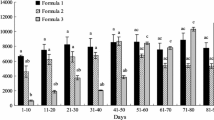Abstract
Pairs of first-year breeding bobwhites were fed constant or variable concentrations of methamidophos for 15 days, or a control diet in a pair-fed design in which they were matched by body weights to pairs in the constant group. Treatments for the constant group were 5.0, 7.8, 12.3, 19.2, and 30.0 ppm for 5 pairs at each concentration. The number of pairs per concentration and peak concentrations for the variable pairs were identical to the constant dosages. Concentrations for the variable group were increased by a factor of four during two 3-day periods in order to reach the peak concentrations on days 7–9 after which they were decreased by 18% every 3 days to correspond to an environmental half-time of 10.5 days. Food consumption, egg production, hatchability of eggs under artificial incubation, and survival of hatched chicks for 2 weeks were recorded for each pair during 15-day treatment and 21-day posttreatment periods. Mortality was high in the highest constant dosage (2/10) and the associated pair-fed groups (3/10). Food consumption and egg production rates were negatively dose-related during the treatment period in the constant and variable groups. The laying rate of pair-fed hens was reduced to the same extent as in the constant group. Reproductive inhibition was not permanent and pairs resumed laying after a dose-related recovery interval. No dose-related effects on hatchability or chick survival were detected. Furthermore, there was no evidence of a pesticide effect on reproduction in addition to that exerted through pesticide-induced anorexia.
Similar content being viewed by others
References
Fitzpatrick GE, Bogan MD (1980) Residue dynamics of acephate and methamidophos in urban dooryard citrus foliage, Pompano Beach, Florida—August–September 1978. Pestic Monit J 14:3–6
Hill EF, Camardese MB (1986) Lethal dietary toxicities of environmental contaminants and pesticides to Coturnix, US Fish and Wildlife Service Technical Report No. 2, Washington, DC (in press)
Kenaga EE, Fink RJ, and Beavers JB (1979) Dietary toxicity tests with mallards simulating residue decline of chlorpyrifos and avoidance of treated food. In: Kenaga EE (ed) Avian and mammalian wildlife toxicology. ASTM STP 693. American Society for Testing and Materials, Philadelphia, pp 36–44
Nigg HN, Reinert JA, Fitzpatrick GE (1979) Acephate and methamidophos residue behavior in Florida citrus, 1976. Pestic Monit J 12:167–171
Stromborg KL (1986) Reproductive toxicity of monocrotophos to bobwhite quail (in press).
— (1981) Reproductive tests of diazinon on bobwhite quail. In: Lamb DW, Kenaga EE (eds) Avian and mammalian wildlife toxicology: Second conference. ASTM STP 757. American Society for Testing and Materials, Philadelphia, pp 19–30
—(1977) Seed treatment pesticide effects on pheasant reproduction at sublethal doses. J Wildl Manage 41:632–642
—, McEwen LC, Lamont T (1984) Organophosphate residues in grasshoppers from sprayed rangelands. Chem in Ecology 2:39–45
United States Environmental Protection Agency (EPA) (1978) Proposed guidelines for registering pesticides in the United States. Federal Register 43(132):29696–29741
Author information
Authors and Affiliations
Rights and permissions
About this article
Cite this article
Stromborg, K.L. Reproduction of bobwhites fed different dietary concentrations of an organophosphate insecticide, methamidophos. Arch. Environ. Contam. Toxicol. 15, 143–147 (1986). https://doi.org/10.1007/BF01059963
Received:
Revised:
Issue Date:
DOI: https://doi.org/10.1007/BF01059963




